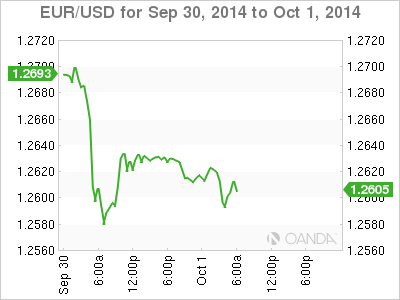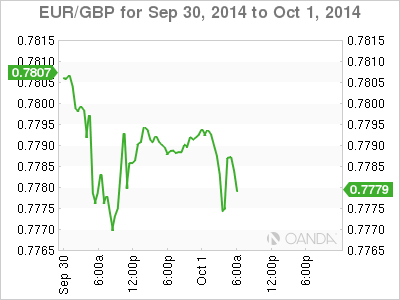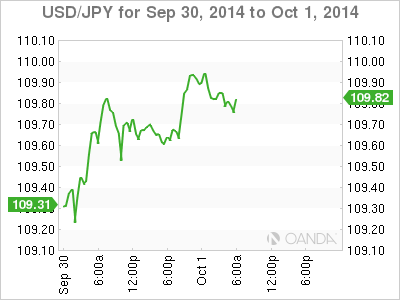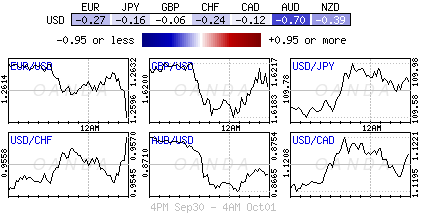A new month and a new quarter should not be capable of changing things up too much. Both forex volume and volatility are not expected to ease off anytime soon as a hint of rate divergence brings with it a lot more opportunities. Hitting the half-way mark of a busy week, one notices that Euro bourses are inching lower, calling time on the previous session’s rally that had been driven by a fall in eurozone inflation to a five-year low. Some investors are expecting that the ECB would be required to be more proactive at tomorrow’s monetary policy meeting.
On reflection, the consensus thought has the ECB policymakers taking time to access the impact of the two waves of stimulus programs introduced last June (negative deposit rates, more credit, and purchases of asset-backed securities and covered bonds). Hence, most forecasters do not anticipate the ECB to jump the gun, believing that when it comes to inflation, the “base effect” (food and energy prices which are historically very low) will climb in October.
Nevertheless, eurozone inflationary pressures are likely to remain soft for some time. Sentiment surveys released earlier this week revealed that both euro businesses and consumers are more downbeat about their prospects in September than at any time since the end of last year. The 18-member single currency is once again threatening to print fresh new lows outright, (€1.2580) and against the majors, after a mixed-run of final September Euro manufacturing PMI’s.
In contrast, the US dollar seems fixated on continuing its recent strong form, backed by the growing strength of the US economy. This is allowing investors to bet that the Fed will soon have to consider raising interest rates. Nevertheless, a weak private sector jobs report later this morning (exp. +207k) could leave the USD exposed and vulnerable to a pullback. Any signs of a US economic weakness could influence the Fed to change-up the timing of their first rate hike, requiring many investors to unravel a good percentage of recent dollar rally.
Euro activity slows at a faster pace
The Eurozone manufacturing sector slowed more sharply than first estimated last month (50.3 vs. 50.7), especially from the “big” guns, Germany and France while Italy, Europe’s third largest economy, is showing a surprising revival.
New signs that the region remains stuck in stagnation, while manufacture’s cut prices for the first time in six-months, will only be putting further pressure on the ECB to be aggressive in taking more dramatic measures to boost euro consumer demand and inflation.
Certainly not a natural support for immediate EUR strength is Germany, the regions backbone, who saw its manufacturing sector recorded a fresh source of weakness, with its PMI falling to a new 15-month low, while indicating that activity had declined. Analysts have noted that the eurozone’s northern industrialized regions are succumbing to “the various headwinds of weak demand, falling business and consumer confidence and waning exports due to the Ukraine crisis and Russian sanctions.”
This morning’s data suggests that euro-manufacturing activity will not be turning around any time soon, as new orders have declined for the first time in 15-months, and export orders rising at the slowest pace in two-years. The knock on effect will see the non-hiring of additional workers and the slashing of end product prices.
With the market expecting the ECB to take time to assess the impact of the two waves of stimulus (credit and purchases of ABS) and because the general malaise has now entered the “core” of the euro industrial region, whatever Euro policy makers decide the market should expect it to be more ” contentious and audacious” in nature, especially since Draghi said that they could use additional unconventional measures.
Eurozone woes impact UK
The UK is faring a tad better despite activity in the manufacturing sector slowing again last month. The PMI for the sector has fallen to a new 17-month low (51.6 vs. 52.2), stronger proof that the strong upsurge in UK manufacturing that was witnessed in the first half of the year seems to have run its course. This could very much begin the change of thought for the BoE. Governor Carney will have to take into consideration whether the UK economy is strong enough to withstand a rise in interest rates.
The headline print came in below market consensus of 52.2 as new-orders slowed for the third consecutive month, while output price growth remains weak. Input prices fell for the first time in five-months, due to lower commodity prices and a stronger GBP. The hint of a slowdown and subdued price pressures may mean that the BoE rate rise will be delayed. Cable initially managed to fall a quarter-cent to test £1.6162, which is September 15 low. Further stop losses are reported sub-£1.6160 with a new Euro resistance level reported above £1.6225-30. Sterling bears medium target remains the pounds 10-month low straddling £1.6052 last visited on Sept 10.
Asia lacks liquidity
Do not underestimate the power and draw of liquidity. Over the past session, Asian markets have been generally flat on low liquidity. With Hong Kong out for a public holiday for the next two days and China off for golden week, market interest will remain relatively dead in that region, at least until US non-farm payrolls on Friday. It is the beginning of a new quarter and both volume and volatility are not expected to ease off anytime soon – this should allow for more market and trading opportunities, certainly more than when the market was being handcuffed by CBank lower for longer policy. A hint of rate divergence brings a lot more opportunities.
This article is for general information purposes only. It is not investment advice or a solution to buy or sell securities.
Opinions are the authors — not necessarily OANDA’s, its officers or directors. OANDA’s Terms of Use and Privacy Policy apply. Leveraged trading is high risk and not suitable for all. You could lose all of your deposited funds.
Recommended Content
Editors’ Picks
AUD/USD: Extra gains in the pipeline above 0.6520

AUD/USD partially reversed Tuesday’s strong pullback and regained the 0.6500 barrier and beyond in response to the sharp post-FOMC pullback in the Greenback on Wednesday.
EUR/USD meets support around 1.0650

EUR/USD managed to surpass the key 1.0700 barrier in response to the intense retracement in the US Dollar in the wake of the Fed’s interest rate decision and Chair Powell’s press conference.
Gold surpasses $2,300 as Dollar tumbles

The precious metal maintains its constructive stance and trespasses the $2,300 region on Wednesday after the Federal Reserve left its FFTR intact, matching market expectations.
Bitcoin price reclaims $59K as Fed leaves rates unchanged

The market was at the edge of its seat on Wednesday to see whether the US Federal Reserve (Fed) would cut interest rates during the Federal Open Market Committee (FOMC) meeting.
The market welcomes the Fed's statement

The market has welcomed the Fed statement, and the S&P 500 is higher in its aftermath, the dollar is lower and Treasury yields are falling. There is still only one cut priced in by the Fed.



